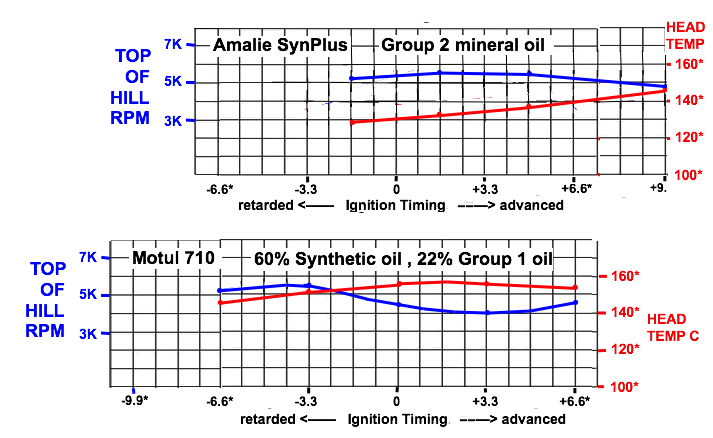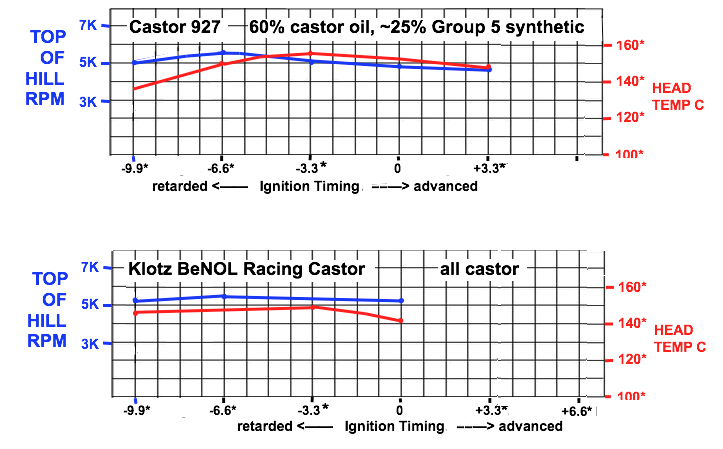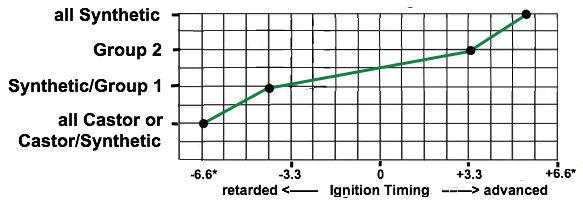|
This big clue prompted me to test the differences between oils regarding best timing: --> When analyzing the molecular composition of petroleum products the range is from very low carbon chain molecules of gasoline and certain solvents, to kerosene, to group 1 mineral oil, then group 2, then group 3, then groups 4 and 5 (synthetics). Solvents Almost all engine oils have some solvent like kerosene added to it to make it more pourable, or even so much so that it can be used in an oil injector system. Usually the lower the density of the product, the more solvent it has. Solvents carbon chains range from slightly less than gasoline to almost twice as much as gasoline but not as much as group 1 oil. The highest density of synthetic oil is 0.95, and for group 1 mineral oil it is 0.84, and for group 2 it's 0.88. So being lower than that indicates it has some dispersant in it. Unfortunately many products are a blend of synthetic and mineral oil so it's hard to tell if they have dispersant. Interestingly enough the progress of oil density's matched the flamability I observed when I lit 3 oils on fire. Motul 800 had .91 density, Bel-Ray Mineral Oil had .88, and SynPlus had .81 density. In the engine the solvents evaporate quickly off the cylinder upon contact, leaving the base oils but they remain in the airborne mix that combusts. So when comparing two similar products you need to take into account that the lower the density, the more solvent is there and that moves the graph (see below) to the left, making the mix more quickly combustible and requiring more retarded timing. The Test So there's a long street uphill leaving my town which keeps my air cooled 48cc from reaching top RPM and so I got the idea of adjusting the ignition timing to see which timing gives the best uphill RPM which indicates best power. I have an adjustable CDI of my own design. The result showed a maximum difference of 10 degrees between one type and another. This means: 1) When changing engine oil type you need to retest for best timing for best peak power or best powerband. 2) If timing adjustment by rotating the stator coil plate is limited then it's possible that the best power can be had by using a fast burn oil with a high RPM engine, and a slow burn oil with a low RPM engine. 5 Engine Oil Types: Fully mineral oil, Synthetic/Mineral blend, Fully synthetic, Synthetic/Castor blend, Fully castor oil. Here's the graph results of the 5 main engine oil types :     Conclusion Group 1 has the lowest carbon chains of all the oils and look at how just 22% content moved the graph to the left for Motul 710, over-riding the influence of its synthetic oil. Very interesting is how stable the graph is for 100% castor, making it somewhat independent of timing. To me that means that some of it is fast burning and some is slow burning. Also of interest is how low the head temp was with it when the timing was overly advanced. I also tested Redline Allsport which is about 20% synthetic and 60% group 1 oil. It had almost the same density as Motul 710 but the excess group 1 oil didn't shift the ideal timing needed to be more retarded as I thought it would. It wound up being the same as Motul 710. So if you have adjusted your timing to what you like best and you then switch type oil then by this info you know to also readjust your timing. For Example: Yamalube is mostly group 2 oil with 29% group 1 oil which would make it a "fast burn" oil, so if you switch from that to a "slow burn" oil then you know to recheck the timing. How To Set Ignition Timing: 1. Use a genuine NGK spark plug, not a cheap copy, of the heat range which you think is right for your engine which will be 1 or 2 #s higher than the stock recommendation if you have modded it for higher RPM. 2. Try different main jets and keep the one that is the biggest w/o causing any sputtering on slight downhills (when engines like lean jetting). If this causes sputtering mid throttle then lower the needle 1 or 2 notches. 3. Try different ignition timings, not changing it by more than 3 degrees each time. To know how far to move the stator coil plate (at its outer edge) for 3 degrees just multiply 0.0262 x stator coil plate diameter. If you ride mostly mid RPM then set it for best power there, and if mostly riding high RPM then set it for best power there. 4. Then look at the spark plug to see where the color change line is on the ground electrode. If closer to the end than at the halfway distance (halfway along the electrode) then the NGK heat range # is too high. And if closer to the weld point than halfway then it's too low. Click here to access my engine oils page which tells the % of each type oil in each engine oil. Click here for my YouTube video on this subject. Engine Oils fully mineral oil: Amalie Pro 2T : 99% group 2 mineral oil Bel-Ray Mineral 2-Stroke Oil : 90% group 2 Castrol Go!: 90% group 2 Amalie SynPlus: 82% group 2 mineral oil Spectro Oils 2T : 75% group 2, 7% group 1 Yamaha Yamalube 2R : 67% group 2, 29% group 1 PJ1 Goldfire Pro Racing : over 35% group 2, under 30% group 1 Bel-Ray SL-2 : 30% group 2, 35% group 1 Golden Spectro : 80% group 2, ~ 5% group 1 Oils with less than 30% group 1 oil: Mineral Oils Amalie SynPlus, Amalie Pro 2T, Golden Spectro, Castrol Go!, Yamalube 2R, Spectro Oils 2T, Bel-Ray Mineral Oil, PJ1 Goldfire Pro. Semi-Synthetics Motul 510, Motul Scooter Expert, Motul 710, Motorex Cross Power, Repsol Moto Off Road, Maxima Premium 2, Lucas Semi-Synthetic Oils with less than 21% group 1 oil: Mineral Oils Amalie SynPlus, Amalie Pro 2T, Golden Spectro, Bel-Ray Mineral Oil, Spectro Oils 2T, Castrol Go! Semi-Synthetic Oils Lucas Semi-Synthetic, Motorex Cross Power, Maxima Premium 2 Mineral Oils with no group 1 oil: Amalie SynPlus, Amalie Pro 2T, Castrol Go!, Bel-Ray Mineral Oil. Semi-Synthetic oils: Putoline MX5, Castrol A747, Red Line AllSport (not recommended due to 60% group 1 oil), Lucas semi-synthetic, Royal Purple HP 2-C, Maxima Premium 2, Motul Scooter Expert, Amsoil Interceptor, Amsoil Dominator, Putoline MX9, Motorex Power Synt, Motul 710, Motorex Cross Power, Motul 510, Maxima Scooter Pro, Castrol Power 1 Racing Fully Synthetic Oils: Maxima Super M, Bel-Ray H1-R, Silkolene Comp 2 Plus, Silkolene Pro 2, Maxima FORMULA K-2 (7.5% mineral oil), Castrol Power1 XR 77, Motul 800 2T Off Road and Road Racing (6% mineral oil), Klotz R-50 Techniplate, Honda Pro Honda HP2, Motul Kart Grand Prix, ELF HTX 976+, Repsol Moto Racing 2T Synthetic/Castor Oils: Silkolene Pro KR2, Penrite 10 Tenths Race Castor, Maxima CASTOR 927 Fully Castor Oils: Klotz BeNOL, Dumonde Tech Racing Castor, Blendzall Ultra Racing Castor "Slow Burn" Oil Selection: Since synthetic and group 2 mineral oils are in this same slow burn category but are somewhat opposite in characteristics (spooge, viscosity, smoke) then it would be convenient to know which engine oil has a balanced mix of the two types. The only possible answer to that are the two oils from Motul which are Scooter Expert and 510. They both have slightly more group 2 mineral oil than synthetic oil and around 17% group 1 oil. That may be enough to move it into the "fast burn" category though. I would choose to test 510 since it doesn't have the melange oil that Scooter Expert has that tips the product more towards being a fast burn type. But I've already acquired a whole years worth of engine oils which was much more money than I should of spent considering that no one ever gives me any donations. Motul 800 is synthetic with 6% of group 2 mineral oil but that isn't even close to being balanced. Click here for the next page which shifts the conclusions I already made due to the overlooked fact that these timing requirements were only for the highest load for the engine. High load situations are those that cause the engine RPM to reduce unless you downshift. These include uphills, sand, mud. With some bike/rider combinations we could also include heavy acceleration as "high load". |